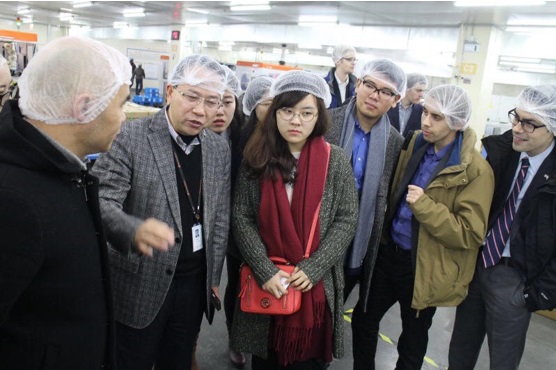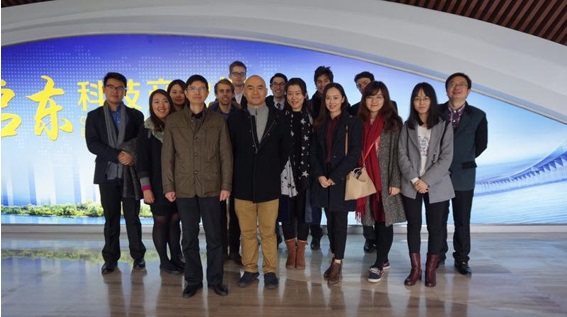Qidong: An Investigation into SEZs
From November 24th to 28th 2016, Master’s candidates of the Tsinghua-SAIS Dual Degree program went on a field trip to Qidong in Jiangsu Province, and Shanghai, as a social practicum module of the class Case Studies of Chinese Political Economy. Initiated by Professor Tang Xiaoyang, the fellows made site visits to the local government, economic development zones, a school, factories, and financial institutions. They also exchanged ideas with the local leaders and experts, learning about economic development in the Yangtze Delta. They saw many examples of China’s past developmental success, and its future ambitions.
On the first day, the fellows attended a seminar with a diverse group of participants from the local subsidiaries of NDRC, MOFCOM and MOE, as well as technical advisors in town. Thanks to its advantageous location and favorable industrial policy, Qidong has established multiple specialized zones with different developmental strengths (including the Qidiong Econmic Development Zone and the Lvsi Port Development Zone), facilitating a rapidly growing industrial sector.
A major instrument for sci-tech expansion and developmental transformation in Qidong, the establishment of the Science and Technology Mayor Group has brought together local government, agencies, and project management offices to work in cooperation. This approach removes conventional barriers and encourages closer ties and interactions between colleges/institutes, research & development, and local industries.
After a brief introduction to the education system in Qidong, the fellows visited the nationally prestigious Qidong High School and spoke with students and faculty members from the International Division. Chinese graduates from the International Division usually enroll in British universities, after completing the Cambridge International Examinations curriculum in their high school classes. Nowadays, this type of preparatory system for quality higher education abroad is becoming increasingly popular among China’s growing middle class.
The fellows then visited a plant of Hanwha, a South Korean energy company, and observed the assembly lines in the factory. Hanwha is a high-tech company specializing in R&D, manufacturing and sale of solar panels, with state-entitled favorable tax exemption. The fellows were impressed by the mostly automated process of solar panel manufacturing, and by the orderly management board of both Chinese and Korean staffers. Later, the fellows proceeded to Bayer’s Qidong factory, where they learned about consumer drug production and sales, and about Bayer’s corporate structure in China.
The next day the fellows had a vehicular tour around the Lvsi Port Economic Development Zone, exploring Lvsi Fisherman’s Wharf and the Embracing Port. Lvsi Economic Development Zone constitutes the largest seaport to Shanghai’s north. With easy access both onshore and offshore, the EDZ forms a layout of “One Port and Three Zones”, namely, the Embracing Port as the center, and the Neighboring Industrial Zone, Fisherman’s Wharf Economic Zone and Petrochemical New Material Zone as the three sides. Lvsi Port now focuses on expanding the “sunset” industries (electric machinery manufacturing, ocean fishery, and power generating) and promoting the “sunrise” industries (new material, high-end devices, and modern shipping).
Crossing the Yangtze over the Chong-Qi Bridge and through the Shanghai Yangtze Chunnel, the fellows left Qidong for Shanghai on the afternoon of 26th, and in the evening passed by the site of the First National Congress of the Chinese Communist Party near Xintiandi. The next day, they visited well-known tourist attractions, including the Chinese Art Museum and the during which they felt strongly about the urban vitality of Shanghai. The gained a clearer picture of the Shanghai civil value of “being a free and inclusive thinker” as well as the civic ethos of “open to diversity, after excellence, of enlightened wisdom and in a humble manner.” On 28th, some of the fellows had an informal meeting with the Dianrong P2P at Xintiandi, with the gola of arranging a formal research investigation on Fin-tech this coming winter. Listed among the top 5 P2P platforms in China, Dianrong P2P is a pioneer in developing overseas businesses, having planned out its international cooperation strategy. So far, the company has signed tentative JV contracts with the Korean P2P market. The winter investigation could be a perfect opportunity to learn more about the practical experiences, opportunities and challenges facing Chinese Fintech companies “going abroad.”
Reactions:
Simon Paetzold: We discussed with the head of the Lvsi port development zone the planning process and the financing structure of the project. This research provided us with excellent opportunities to communicate directly with Chinese government officials.
Qiu Huiyi: The Science and Technology Mayor Group showed great familiarity with the policies of the central government, and an in-depth understanding of the advantages of local towns in industrial development. They also acted as a bridge in connecting policies and local development.
Patrick Cho: In order to better understand the education system in Qidong, we visited Qidong Middle School, and discussed the changing trend of China’s higher education. Although education abroad was extremely popular in China in the past, the popularity now may be declining.
Huang Xiaojia: During this field trip, we learned that Qidong takes lessons from other industrial areas, trying to avoid negative effects of disproportionate development while striving to achieve steady development. I believe that this down-to-earth approach will bring greater positive returns in its development.
Minjoo Jang: It is often thought that Chinese local governments pay little attention to environmental protection, so we were all pleasantly surprised when we learned the Qidong government attachs great importance to the use of clean energy and imposes strict supervision on the local chemical industry.



